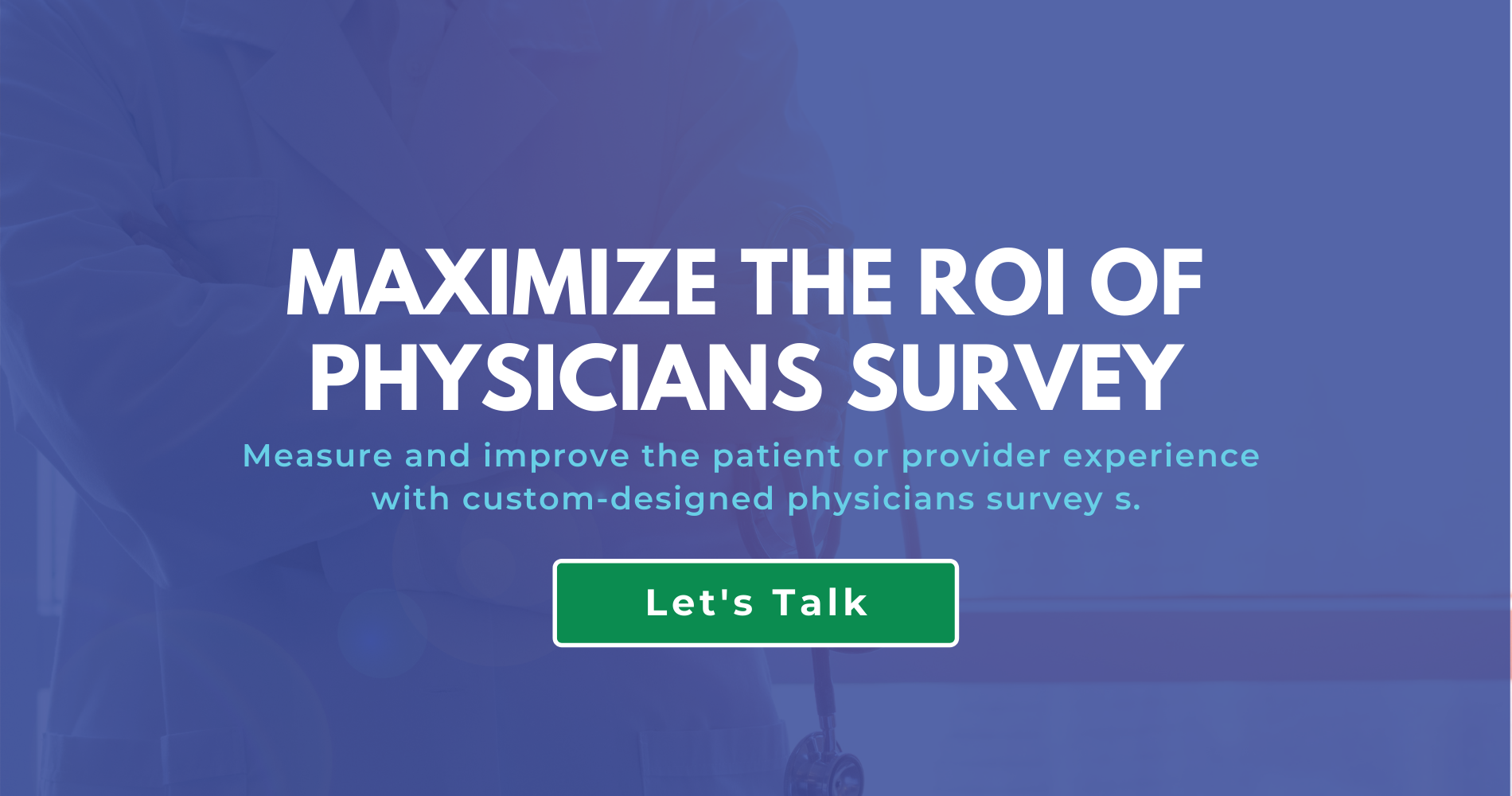
In the rapidly evolving landscape of healthcare, understanding the perspectives of physicians is invaluable.
Surveying physicians can offer crucial insights into their experiences, challenges, and preferences, ultimately leading to improved patient care and more effective healthcare systems.
Whether you're a healthcare administrator, researcher, or simply someone passionate about enhancing medical practices, conducting a physician survey can be a powerful tool in your arsenal.
In this blog post, our healthcare market research company walks you through the entire process, providing essential tips and even example questions to help you gather the data you need effectively and ethically.
Drive Research executes physician surveys for healthcare practices across the country. Contact our team by emailing [email protected] or filling out an online form.
What Are Physician Surveys?
A physician survey is a structured method of collecting data and feedback from physicians, typically aimed at gaining insights into various aspects of their professional practice.
These surveys are designed to gather information on a wide range of topics, including but not limited to:
- Clinical Practices: This can include questions about treatment approaches, prescription habits, and adherence to clinical guidelines.
- Patient Interactions: Survey questions may focus on communication skills, bedside manner, and patient-centered care.
- Workflow and Administrative Processes: This area may cover topics such as electronic health record (EHR) systems, administrative tasks, and time management.
- Perceptions of Healthcare Policies: Physicians may be asked for their opinions on healthcare policies, insurance, and the impact of regulations on patient care.
- Technology Adoption: Surveys might investigate the use of cutting-edge technologies in medical practice and any challenges faced in their implementation.
- Ethical Dilemmas and Decision-making: This category can delve into scenarios involving medical ethics, end-of-life care, and other complex situations.
You can survey physicians through various means, including online platforms, paper forms, or even in-person interviews.
Value of Surveying Physicians
The data collected from physician surveys can be analyzed to identify trends, challenges, and areas for improvement within the medical field.
This information can then be used to enhance healthcare delivery, inform policy decisions, and improve the overall well-being of physicians and their patients.
Plus, prioritizing patient experience is especially important now, as 60% of patients have reported a poor healthcare experience in the recent past. The more reliable medical feedback a healthcare company has to choose from, the better its offerings will be.
Recommended Reading: Tips for Conducting Market Research with Doctors and Physicians
Steps to Surveying Physicians
As with every market research project, our online survey company follows a certain set of steps to ensure we get the best data.
Below, we'll briefly cover the key steps that go into surveying doctors.
Step 1. Kickoff Meeting
A kickoff meeting is integral for any market research project. It's the chance for our research team to meet with the client.
Not only is it a great way for both teams to become acquainted, but it's a chance to establish project goals.
These meetings typically cover:
- Key goals and objectives
- Client expectations
- Overview of timeline and responsibilities
- Additional questions and concerns
Step 2. Writing & Design
After the objectives have been squared away, the survey can be written.
When writing a questionnaire for doctors and physicians, it's important to keep it short, more so than when designing surveys for other audiences.
Since doctors are very busy, they don't have a lot of free time. To get high response rates, the surveys need to be short so doctors can fit them into their schedules.
Our recommendation is no more than five minutes.
Additionally, a significant amount of time is spent on the design portion of the survey as well.
- How do the questions flow?
- Is there a variety of question types?
These are the questions researchers will ask themselves when creating a quality survey to keep respondents engaged.
Step 3. Testing & Fieldwork
After the questions are written and programmed, the survey will be tested to ensure everything is squared away.
A common form of testing a survey is through a soft launch. This step allows a survey to be sent out among a small pool of respondents versus the entire group at once.
If there's an error in the survey, it will only be seen by a small number of respondents and can be corrected prior to the full launch.
From there, full fieldwork will begin. This term refers to the period when the physicians take the survey. It typically lasts a few weeks but can be short or longer depending on the goal response rate.
Step 4. Analysis & Reporting
One of the final steps in the process, analysis begins once fieldwork ends.
During this phase, the data will be checked to ensure quality. This is a time-consuming process, and for good reason! Our team only uses the best data to come to a final conclusion.
This involves:
- Consistency across answers
- Cleaning open ends
- Checking for skip patterns
- Removing duplicate responses or poor-quality responses
Lastly, the reporting process entails putting the data together to be presented to the client.
The report will include sections such as key findings, common themes, and recommendations for how to use the data moving forward.
Along with the full report, Drive Research holds a final meeting to review it in person with our client.
Much like the kickoff meeting, we find this is a great way to close the research process. Any final questions or concerns will be addressed.
Physicians Survey Case Study
The greatest way our healthcare market research company can explain how to conduct a physician's survey is by showcasing a real-world example. Below we outline our step-by-step approach.
The Challenge
A psychiatric non-drug treatment provider was experiencing a higher-than-normal attrition rate for its advanced therapy system solution.
Like most healthcare practices and organizations, they were curious if the COVID-19 pandemic was impacting patient attrition rates.
This is the question our client hoped to answer by conducting a physician survey with our healthcare market research company.
Determining the Physicians Survey Objectives
The first step to conducting a physician survey is determining the objectives of the market research. Our market research team likes to identify the objectives in a project kick-off meeting.
Doing so helps align the survey questions with what key findings are to be uncovered.
The psychiatric non-drug treatment provider specializes in transcranial magnetic stimulation (TMS) therapies. They sought to explore the implications of the pandemic on business practices for psychiatric physicians and the usage of TMS.
This insight would help their team better understand what is driving current attrition rates.
Specifically, the physician survey objectives included:
- Measuring use of telemedicine during the pandemic
- Identifying trends among patient referrals and diagnosis
- Barriers to using TMS
- Identifying trends in TMS usage
- Identifying resources used by physicians to learn more about their practice
Writing Physicians Survey Questions
After determining the objectives of the TMS therapy provider, our market research company began drafting questions for the online survey.
Example physician survey questions include:
- How are practices treating patients during the pandemic?
- What trends are practices seeing as a result of the pandemic?
- What is the current perception of TMS and what changes are expected in the future?
- What barriers exist to increasing the usage/adoption of TMS?
- How are physicians obtaining information about their practice area during the pandemic?
Once the survey document was approved by the client, our telemedicine market research company programmed the questionnaire.
The survey included 42 questions, which took respondents an average of 10 minutes to complete.
Finding Physicians to Survey
One of the greatest challenges for healthcare market research is finding qualified respondents and participants.
The primary audience who took the physicians survey were psychiatrists, neurologists, and TMS technicians or coordinators.
The screening criteria determined by the healthcare client included:
- Relevant practice specialty (Psychiatry, Neurology, etc.)
- Actively practicing
- Office-based practice (panel only)
- The respondent and the respondent's family members don’t work in a relevant industry
- Currently treats 10 or more patients with Major Depressive Disorder (MDD) per month
- Owns a TMS machine, would be likely to consider purchasing a TMS machine, or refers out to a TMS service provider
To find respondents based on these unique criteria, our market research company utilized a third-party email panel and the client’s customer email list.
In other cases, we recommend using social media platforms such as Facebook to find qualified survey takers. It all depends on who your target audience is!
Surveying Physicians
Before sending the survey to fieldwork, our telehealth market research company tested the programming to ensure it was working as anticipated.
We also provided the client with an online testing link so that they could complete the survey from the eye of a respondent.
Additionally, when fielding any online survey, Drive Research recommends making this process two-fold.
First, send the physicians survey to a small sample of respondents, then review the data to verify there are no errors or glitches in the system.
After performing quality checks, the online survey can be sent to the remaining list of respondents.
Fieldwork for the physicians survey began on October 29 and ended on November 11, 2020. The goal number of responses was 200. To incentivize survey completion, the client raffled $50 electronic gift cards.
Reporting Results of a Physicians Survey
The last stage of the process: reporting. Drive Research offers our healthcare clients a variety of reporting options to match their unique needs.
For this particular study, our client asked for a comprehensive market research report.
The physicians survey market research report included:
- Project overview
- Executive summary
- Detailed charts and findings of each survey question
- Infographic
- Appendix
While the findings remain confidential with the TMS therapy provider, the goals of the physician survey were successfully met. The client will use these results to drive the next steps in marketing and sales strategy.
Frequently Asked Questions About Surveying Physicians
How do you survey a physician?
To survey a physician, you should first determine the purpose and objectives of the survey. Then, design a clear and concise questionnaire with relevant questions. You can use various channels like email, online platforms, or even paper-based surveys, and consider follow-up reminders to boost response rates. Additionally, offer incentives or express gratitude for their participation.
Are physician surveys worth it?
Yes, physician surveys are invaluable for gathering insights into their clinical practices, opinions, and experiences. They provide essential data for healthcare research, policy-making, and quality improvement initiatives. Additionally, feedback from physicians can lead to better patient care, enhanced healthcare systems, and advancements in medical knowledge.
How to obtain excellent response rates when surveying physicians?
To obtain high response rates from physicians, it's crucial to...
- Establish trust and convey the significance of their input
- Use personalized invitations, emphasize the relevance and impact of the survey, and assure confidentiality
- Keep the questionnaire concise, focused, and easy to complete
- Employ multiple channels for outreach and consider follow-up reminders
- Offer incentives or acknowledgments for their time and effort
Contact Us to Survey Physicians
Drive Research, a national market research company, specializes in qualitative and quantitative services for healthcare practices across the country. Our team has experience conducting patient satisfaction surveys, telehealth surveys, physician surveys, and more.
To learn more about our healthcare market research services or receive a custom project proposal, contact Drive Research in any of the four ways below.
- Message us on our website
- Email us at [email protected]
- Call us at 888-725-DATA
- Text us at 315-303-2040

Emily Rodgers
A SUNY Cortland graduate, Emily has taken her passion for social and content marketing to Drive Research as the Marketing Manager. She has earned certificates for both Google Analytics and Google AdWords.
Learn more about Emily, here.


